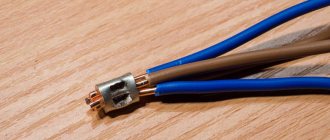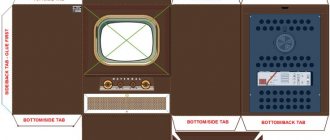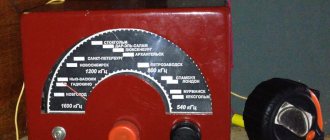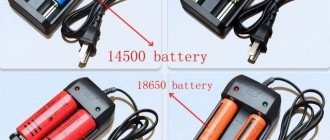Electric field indicators can be used for individual protection of electricians when searching for faults in electrical networks.
With their help, the presence of electrostatic charges in semiconductor, textile production, and storage of flammable liquids is determined.
When searching for sources of magnetic fields, determining their configuration and studying the stray fields of transformers, chokes and electric motors, one cannot do without magnetic field indicators.
Magnetic field indicator circuit
An indicator assembled from several parts turns out to be completely non-inertial and relatively sensitive to, for example, determine the magnetization of a razor blade or a watch screwdriver. In addition, such a device will be useful in school to demonstrate the phenomenon of induction and self-induction.
What is the working principle of magnetic field indicator circuit? If a permanent magnet is carried near a coil, preferably with a steel core, its lines of force will intersect the turns of the coil. An EMF will appear at the coil terminals, the magnitude of which depends on the magnetic field strength and the number of turns of the coil. All that remains is to amplify the signal taken from the coil terminals and apply it, for example, to an incandescent lamp from a flashlight.
The sensor is an inductor L1 wound on an iron core. It is connected through capacitor C1 to an amplifier stage made on transistor VT1. The operating mode of the cascade is set by resistors R1 and R2. Depending on the parameters of the transistor (static transmission coefficient and reverse collector current), the optimal operating mode is set by variable resistor R1.
A composite transistor VT2-VT3 made up of transistors of different structures is included in the emitter circuit of the first stage transistor.
The load of this transistor is the HL1 signal lamp. To limit the maximum collector current of transistor VT3, there is a resistor R3 in the base circuit of transistor VT2.
As soon as a magnetized object is near the sensor core, the signal that appears at the coil terminals will intensify and the signal lamp will flash for a moment. The larger the object and the stronger its magnetization, the brighter the flash of the lamp.
Magnetic field indicator circuit, as a sensor, it is best to use a coil with a core from electromagnetic relays RSM, RES6, RZS9 or others, with a winding resistance of at least 200 Ohms. Please note that the greater the winding resistance, the more sensitive the indicator will be.
Good results are obtained with a homemade sensor. For it, take a piece of rod with a diameter of 8 and a length of 25 mm from 600NN ferrite (from the magnetic antenna of pocket receivers). At a length of approximately 16 mm, 300 turns of PEV-1 0.25 wire are wound in bulk onto the rod. 0.3, placing them evenly over the entire surface. The winding resistance of such a sensor is approximately 5 Ohms. The sensitivity of the sensor, necessary for the operation of the device, is ensured due to the high magnetic permeability of the core. Sensitivity also depends on the static current transfer coefficient of the transistors, so it is advisable to use transistors with the highest possible value of this parameter. In addition, transistor VT1 must have a small reverse collector current. Instead of MP103A, you can use KT315 with any letter index, and instead of MP25B, you can use other transistors of the MP25, MP26 series, with a transmission coefficient of at least 40.
Magnetic field indicator diagram and location of radio components. Mount some of the indicator parts on a board made of any insulating material (getinax, textolite, hardboard). Mounting is mounted; to solder the pins of the parts, install pins 8.10 mm long from thick (1.1.5 mm) tinned copper wire on the board. Instead of studs, you can rivet hollow rivets on the board or install small brackets made of tin from a tin can. Do the same in the future when making boards for surface mounting. Make connections between the studs with bare tinned mounting wire, and if the conductors intersect, put a piece of polyvinyl chloride tube or cambric on one of them.
Magnetic field indicator circuit board
After installing the parts, a sensor, a variable resistor, a signal lamp, a switch and a power source are soldered to the board with insulated conductors. Turning on the power, set the variable resistor slider to such a position that the lamp filament barely glows. If the thread is very hot even with the engine in the upper position according to the diagram, you should replace resistor R2 with another one with a higher resistance.
A small magnet is placed briefly in front of the sensor core. The lamp should flash brightly. If the flash is weak, this indicates a low transmission coefficient of transistor VT1. It is advisable to replace it.
Then you need to bring the end of a magnetized screwdriver closer to the sensor core. It is not difficult to magnetize it with a few touches of a relatively strong permanent magnet, such as a 1 W dynamic head magnet. With a magnetized screwdriver, the brightness of the warning lamp flash will be less than with a permanent magnet. The flash will be very weak if you use a magnetized safety razor blade instead of a screwdriver.
Fluxgate (vector) magnetometers
One type of magnetometer is fluxgate . The fluxgate was invented by Friedrich Förster in 1937 and serves to determine the vector of magnetic field induction.
You can read about my fluxgate magnetometer prototype here.
Fluxgate design
single rod fluxgate
The simplest fluxgate consists of a permalloy rod on which a drive coil, powered by alternating current, and a detector coil are placed.
Permalloy is an alloy with soft magnetic properties, consisting of iron and 45-82% nickel. Permalloy has high magnetic permeability (maximum relative magnetic permeability ~100,000) and low coercivity. A popular brand of permalloy for the manufacture of fluxgates is 80НХС - 80% nickel + chromium and silicon with a saturation induction of 0.65-0.75 T, used for cores of small-sized transformers, chokes and relays operating in weak fields of magnetic screens, for cores of pulse transformers, magnetic amplifiers and contactless relays, for magnetic head cores. The dependence of relative magnetic permeability on field strength for some varieties of permalloy has the form –
If a constant magnetic field is applied to the core, then a voltage of even harmonics appears in the measuring coil, the value of which serves as a measure of the strength of the constant magnetic field. This voltage is filtered and measured.
double-rod fluxgate As an example, we can cite the device described in the book by V.N. Karalis. “Electronic circuits in industry” –
The device is designed to measure constant magnetic fields in the range of 0.001 ... 0.5 oersted. The excitation windings of the sensor L1 and L3 are connected in opposite directions. Measuring winding L2 is wound on top of the field windings. The field windings are powered by a 2 kHz current from a push-pull generator with inductive feedback. The generator mode is stabilized by direct current by a divider on resistors R8 and R9.
fluxgate with a toroidal core One of the popular design options for a fluxgate magnetometer is a fluxgate with a toroidal core (ring core fluxgate) -
Compared to rod fluxgates, this design has less noise and requires the creation of much less magnetomotive force.
This sensor consists of an excitation winding wound on a toroidal core, through which an alternating current flows with an amplitude sufficient to bring the core into saturation, and a measuring winding from which an alternating voltage is removed, which is analyzed to measure the external magnetic field. The measuring winding is wound over the toroidal core, covering it entirely (for example, on a special frame) -
This design is similar to the original fluxgate design (a capacitor is added to achieve resonance at the second harmonic) –
https://motivationtolearn.org/wordpress/?p=1347 describes a fluxgate with a core made of a coil of copper-plated steel wires for telephony HC-734A with a diameter of 0.5 mm - The field winding contains about 200 turns. Two capacitors of 0.47 μF and 0.22 nF are connected in parallel to the winding, which serve to isolate the first harmonic sine wave from a rectangular signal with a frequency of 2.5 kHz coming from the output (leg 3) of the NE555 timer through a 10 kOhm potentiometer and a 10 μF capacitor. The measuring winding contains 500 turns with a 3.3 nF capacitor connected in parallel, which tunes the circuit to resonance at the second harmonic frequency of 5 kHz. The author of this project is Graeme Keon:
orthogonal fluxgate Orthogonal fluxgates are also used –
In the case of an orthogonal fluxgate, its core corresponds to the cylinders (“barrels”) (ferrite beads) used in ferrite filters placed on various cables. The dimensions of these cylinders differ from each other -
Operating principle of fluxgate
A fluxgate is a type of ferroinduction converter. The main feature of such converters is the change in the magnetic permeability $mu$ of the core under external influence (mechanical, thermal or magnetic).
Let's consider the principle of operation of a fluxgate with a toroidal core. In the absence of an external magnetic field, no EMF is induced in the measuring coil, since the magnetic fluxes created by the field winding current in the two halves of the core are equal in magnitude and opposite in direction and are mutually compensated. If an external magnetic field is applied to the core, then an imbalance occurs, since in one half of the core this field is added to the excitation field, and in the second it is subtracted. Because of this, an EMF is induced in the measuring winding, which takes the form of short pulses.
To estimate the strength of the external magnetic field, the value of the second harmonic of this EMF is analyzed, since the asymmetry of the sensor is more pronounced in the occurrence of odd harmonics.
block diagram of fluxgate
Professional fluxgate magnetometers
Ebinger Magnex
Foerster Ferex
Schiebel Dimads (three-axis)
Applications of fluxgate magnetometers Fluxgates are used to search for minerals (e.g. oil), baggage inspection, materials examination, testing the effectiveness of magnetic shielding, searching for underwater pipelines...
The Tybee Bomb Incident The most exotic case is the use of a fluxgate to search for an American atomic bomb lost near the Californian coast. This incident was called the Tybee Bomb. On February 5, 1958, the pilot of a B-47 Stratojet bomber was forced after a mid-air collision with an F-86 Saberjet fighter to drop a Mark 15 hydrogen bomb from an altitude of 7,200 feet into the ocean off the southern shore of the uninhabited island of Little Tybee to ensure a safe landing - the bomb MK15
B-47 crew (from left to right – Howard Richardson, Robert Lagerstrom, Leland Woolard)
The bomb was never found! You can read more about this in the interesting book “Chasing Loose Nukes” by Colonel Derek L. Duke:
Search for submarines On the Natural Resources Canada website in the virtual museum (https://geomag.nrcan.gc.ca/lab/vm/fluxgate-eng.php) there is a fluxgate magnetometer used during the Second World War to search for submarines from the air –
The website of John H. Lienhard (https://www.uh.edu/engines/epi2381.htm) shows a photograph of an airplane in the air with a suspended fluxgate -
Hall sensor module KY-003
This module is designed to detect a magnetic field using the Hall effect. This effect consists in the fact that a transverse potential difference 3 appears in a conductor with direct current placed in a magnetic field.
Dimensions 28 x 15 mm, module weight 1.2 g. The board has two mounting holes with a diameter of 2 mm at a distance of 10 mm from each other. A three-pin connector is used for connection. The central contact is +5V power supply, the “-” contact is common, the “S” contact is informational. When the magnetic field induction exceeds the specified value at the information output of the module, the high logic level changes to low. The module has an LED that lights up when the sensor is triggered. As an illustration, you can load the LED_with_button [4] program onto the Arduino UNO board and connect this module instead of the button.
The module triggers only on the north pole of the magnet, the trigger threshold is quite high, the magnet must be brought close. The current consumption is 6.3 mA in standby mode and is 11 mA when triggered.
Among the disadvantages, it should be noted that it is quite difficult to find the mutual configuration of the magnet and the sensor for reliable operation.
Since the module responds to a certain threshold value of the magnetic field, the most obvious application of such a sensor would be to use this sensor instead of a reed switch. Although the reed switch is a very reliable device, its design still contains moving mechanical contacts; in contrast, the Hall sensor does not have any moving parts. For example, you can install this module on a door jamb, install a magnet on the door leaf opposite it, you will get a door opening sensor for an alarm or a smart home, similarly, you can organize the counting of wheel revolutions by attaching a magnet to it and placing this sensor in close proximity to it.
Build process
Assembly requires the use of a breadboard of at least 15 x 24 holes, and special attention is paid to the layout of the elements on it. The photographs show the recommended location of each radio element and what connections to make between them. Jumpers on a printed circuit board can be made from cable fragments or cut off legs from other elements (resistors, capacitors) that remain after their installation.
First you need to solder the coils L1 and L2. It's good to move them away from each other, which will give us space and increase the stereo effect. These coils are the key element of the circuit - they act like antennas that collect electromagnetic radiation from the environment.
After soldering the coils, you can install capacitors C1 and C2. Their capacitance is 2.2 μF and determines the lower cutoff frequency of sounds that will be heard in the headphones. The higher the capacitance value, the lower the sounds reproduced in the system. Most powerful electromagnetic noise lies at 50 Hz, so it makes sense to filter it out.
Next, we solder 1 kOhm resistors – R1 and R2. These resistors, together with R3 and R4 (390 kOhm), determine the gain of the operational amplifier in the circuit. Voltage inversion is not particularly important in our system.
The virtual ground is resistors R5 and R5 with a resistance of 100 kOhm. They are a simple voltage divider, which in this case will divide the 9 V voltage by half, so from a circuit point of view the m/s is powered by -4.5 V and +4.5 V in relation to the virtual ground.
You can put any operational amplifier with standard pins into the socket, for example OPA2134, NE5532, TL072 and others.
We connect the battery and headphones - now we can use this acoustic monitor to listen to electromagnetic fields. The battery can be glued to the board with tape.
Module based on reed switch KY-021
The sensor is a normally open reed switch with an additional resistance of 10 kOhm 5.
The module dimensions are 24 x 17 mm, weight 1.2 g. A three-pin connector is used for connection. The central contact is +5V power supply, the “-” contact is common, the “S” contact is informational.
Hall Sensor Module (Linear) KY-024
The module is designed to measure the strength of a constant magnetic field 10.
The module dimensions are 44 x 15 x 13 mm, weight 2.8 g, the module board has a mounting hole with a diameter of 3 mm. The sensing element is the Hall sensor SS49E. Power supply is indicated by LED L1.
The sensor has four contacts. “A0” is an analog output, the voltage at which varies depending on the magnetic field induction. Power terminals “G” – common wire, “+” – +5V power supply. There is a low logic level at the digital input “D0”; if the magnetic field strength does not exceed a specified threshold, when the sensor is triggered, the low level changes to high. The response threshold of the digital channel of the sensor can be changed using a multi-turn trimming resistor. When the sensor is triggered, LED L2 lights up.
Current consumption is 9 mA in standby mode and 11 mA when triggered.
The module only responds to the north pole of the magnet. Maximum sensing distance 6 mm.
The analog channel allows you to organize the measurement of quantitative characteristics of the magnetic field. The readings on the Arduino UNO analog port vary from 550 to 200 units depending on the distance to the magnet (the AnalogInput2 program was loaded into the Arduino UNO memory).
Setting up magnetometers
Helmholtz coils can be used to test the fluxgate . Helmholtz coils are used to produce a nearly uniform magnetic field. Ideally, they represent two identical annular turns connected to each other in series and located at a distance of a turn radius from each other. Typically, Helmholtz coils consist of two coils on which a certain number of turns are wound, and the thickness of the coil should be much less than their radius. In real systems, the thickness of the coils can be comparable to their radius. Thus, we can consider a system of Helmholtz rings to be two coaxially located identical coils, the distance between the centers of which is approximately equal to their average radius. This coil system is also called a split solenoid.
In the center of the system there is a zone of uniform magnetic field (the magnetic field in the center of the system in the volume of 1/3 of the radius of the rings is uniform within 1%), which can be used for measurement purposes, for calibrating magnetic induction sensors, etc.
Magnetic induction at the center of the system is defined as $B = mu _0,{left( {4over 5}right) }^{3/2} , {INover R}$, where $N$ is the number of turns in each coil, $I$ is the current through the coils, $R$ is the average radius of the coil.
Helmholtz coils can also be used to shield the Earth's magnetic field. To do this, it is best to use three mutually perpendicular pairs of rings, then their orientation does not matter.
Module with reed switch KY-025
The sensitive element of the module is a regular reed switch, working together with a comparator on the LM393YD chip; according to the sellers, 13 this allows you to reduce the current flowing through the contacts of the reed switch, and thereby increase its resource.
The module dimensions are 45 x 18 x 13 mm, weight 2.8 g, similar to the previous case, the module board has a mounting hole with a diameter of 3 mm. Power is indicated by LED L1.
When the reed switch is activated, LED L2 lights up. Current consumption is 3.7 mA in standby mode and 5.8 mA when triggered.
It is unclear what sensitivity threshold should be regulated by a variable resistor; apparently these modules with the LM393YD comparator are standard and various sensors are soldered to them depending on the purpose of a particular module. Of course, the module works discretely like a button, which can be verified using the LED_with_button program [4]. The supply voltage +5V is constantly present at pin “A0”. Power terminals “G” – common wire, “+” – +5V power supply. There is a low logic level at the digital input “D0”; when the reed switch is triggered, the low level changes to high. The feasibility of this module, according to the author, is controversial, given that even in the simplest case of turning on a reed switch such as the KY-021 module, the current flowing through the reed switch contacts is significantly less than one milliampere.
Hall sensor module KY-035
This module is an SS49E chip, without any additional devices [14]. The installation of the microcircuit on the board in this case can only be explained by the requirements of unification when creating this set of sensors.
The module dimensions are 29 x 15 mm, weight 1.2 g. A three-pin connector is used for connection. The central contact is +5V power supply, the “-” contact is common, the “S” contact is informational.
The current consumed by the module is about 6 mA and does not depend on the state of the sensor.
In the absence of an external magnetic field, a voltage equal to half the supply voltage is present at the information output. An external constant magnetic field causes the voltage at the information output to increase or decrease depending on the polarity of the magnet. You can easily verify this using the AnalogInput2 program
Using this module, you can control the distance to the source of the magnetic field, count the number of revolutions, etc. The microcircuit is sensitive to a magnetic field with induction in the range of 600-1000 Gauss [15].
Additional features
What can be added to increase functionality? The volume control is two potentiometers between the output from the circuit and the headphone jack. Power switch - the circuit is now on all the time until the battery is disconnected.
During testing, it turned out that the device is very sensitive to the field source. You can hear, for example, how the screen on your mobile phone is updated, or how beautifully the USB cable sings while transferring data. When attached to a switched-on loudspeaker, it works like a regular and quite accurate microphone that collects the electromagnetic field of the coil of a working speaker.
It looks good for cables in the wall, like a locator. You just need to raise the bass by increasing all 4 capacitances to 10 µF. The disadvantage is that there is quite a lot of noise and the signal is also too weak - you need some kind of additional power amplifier, for example on the PAM-8403.
useful links
- https://ru.wikipedia.org/wiki/Hall_Effect
- https://arduino-kit.ru/catalog/id/modul-datchika-holla
- https://www.14core.com/wiring-hall-effect-sensor-switch-magnet-detector-module/
- https://robocraft.ru/blog/arduino/57.html
- https://arduino-kit.ru/catalog/id/modul-na-osnove-gerkona
- https://www.zi-zi.ru/module/module-ky021
- https://2shemi.ru/mehanicheskie-datchiki-dlya-arduino/
- https://electrosam.ru/glavnaja/slabotochnye-seti/oborudovanie/gerkony/
- https://electrik.info/main/school/419-gerkony-sposoby-upravleniya.html
- https://arduino-kit.ru/catalog/id/modul-datchika-holla-_lineynyiy_
- https://www.zi-zi.ru/module/module-ky024
- https://arduino-kit.ru/catalog/id/modul-magnitnyiy-datchik-s-gerkonom
- https://www.zi-zi.ru/module/module-ky025
- https://arduino-kit.ru/catalog/id/modul-datchika-holla_
- https://ru.wikipedia.org/wiki/Gauss_(unit)
All documentation and program files are located in a common archive. Review prepared by Denev.
Source










